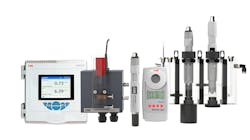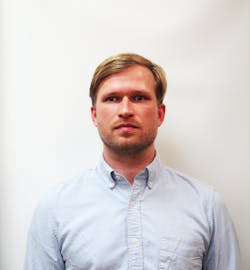Chlorine measurement has been around since the early 1900s when chlorine disinfection was introduced to disinfect water sources, a vital part of the treatment process. WaterWorld spoke with ABB’s Continuous Water Analysis Global Product Manager Nikodem Siwek during WEFTEC about the company’s latest advancements in chlorine measurement technology aimed at improved measurement stability and less frequent maintenance.
Bob Crossen: Could you talk about the role that chlorine disinfection plays in municipal and industrial applications for water and wastewater?
Nikodem Siwek: Certainly! So, in disinfection schemes there are many different methods of disinfection. Chlorine is just one of them. But chlorine is one of the more simple implementations for disinfection purposes because it doesn’t require a complex infrastructure and therefore it’s a low-cost method. So a lot of municipal and industrial facilities around the world implement chlorine disinfection in their process to ensure water disinfection. But chlorine also has other advantages. It has a pre-treatment benefit that helps reduce manganese, iron and hydrogen sulfide in treated water, which affect taste, smell and discoloration. In addition, it also has a post-treatment benefit in that the residual chlorine in the water, after initial treatment, helps to keep it safe as it is distributed through pipes to where it is needed. So there’s a lot of benefits to using chlorination in your drinking water facility.
Crossen: So, there are good benefits, but I imagine there are also challenges like any type of technology. Could you speak to some of the challenges that you see?
Siwek: Yeah, correct. When we were developing our new next generation chlorine sensors and products, we interviewed customers to see what their challenges are, what are their gains, and what they struggle with in the process. Common reoccurring things we heard are the need of frequent maintenance, which is very time consuming and costly, and the issue of measurement confidence. Chlorine measurements tend to drift and that can be either related to process issues or sensor issues, so a lot of customers struggle with identifying what those drifts are and how to identify them. A lot of times, customers are challenged with verifying their measurement, making sure they’re comfortable with the value, and knowing that it’s accurate.
Crossen: What types of solutions are you guys doing at ABB to try and address those particular challenges?
Siwek: At WEFTEC, we are previewing our new ChloroStar family that will launch soon. It comprises of a range of sensors, transmitters and accessories to help customers install, commission and operate these chlorine measurement instruments with a high degree of confidence and ease. So in our new launch, we will have a range of sensors and cells designed to measure free and total chlorine. Like I said before, the two common things we’ve come across when it comes to customer gains is reducing maintenance related tasks and increasing measurement confidence. The way that we addressed these is that we provide solutions that are very easy to install and feature advanced functionality that will notify you and help you identify any drift related to process issues or sensor issues. For example, pH variance is a common cause of drift in chlorine measurement, especially the higher the pH level increases. Typically above 6.5 pH, small fluctuations of pH can have massive impact on chlorine levels. Most applications run around 6.5 or 7.5 pH, so they will have issues with stability and accuracy in fluctuating pH samples. The way we combat that with the ChloroStar family is to provide additional pH compensation with the measurement through a flow or pH drift alarm that is capable notifying you when there is a fluctuation of pH. In addition, we also have built-in pH compensation, so if there is drift, there’s an internal algorithm to help you compensate for the foreign value to ensure accuracy throughout the range of the product.
Crossen: What additional benefits does this technology provide then?
Siwek: One of the new features that we introduced on our chlorine system is the steady flow module. If you look at typical chlorine measurement, they become unreliable if the amount of flow past the sensor gets too low. Typically, this is around 10 liters per hour. The reason for this is because chlorine is consumed on the sensor, so if you don’t have a fast enough flow rate to replenish the chlorine the value starts drifting lower. It’s usually a challenge and a balancing act between how much water you waste versus accuracy and stability of the measurement. With the addition of this steady flow module on the ChloroStar sensor, we are able to measure down to one liter per hour, which is a very low value. This helps reduce waste while maintaining the accuracy of your measurement.
Crossen: So, what does the future hold? You’ve addressed so many things already. What could possibly be next?
Siwek: Exactly. Chlorine measurement has been around since the early 1900s with the introduction of chlorine disinfection, so the technology has been around for quite a long time. We’ve seen development of metric sensors and colorimetric methods. These have their proven benefits, so there is not really much in terms of development on the chlorine measurement side. But we are now seeing improvements in the implementation of data and how we use it to better control our processes. This includes things like developing ways to make access to information easier and how to use that information to provide better support for our customers and better management of their process. For example, at ABB we’ve launched an app that allows you to communicate with the transmitter via bluetooth technology. So now you have on-the-go live information on your chlorine measurements delivered to your smart devices such as a handheld phone or a tablet. You can read your process data through the device and are also able to resource and pull up information like product data sheets, manuals and product videos to help you troubleshoot and resolve any potential issues. In addition, you can also do things like configurations, remote configurations, software uploads and downloads from your smart device to make it really easy to commission the ABB ChloroStar solutions and improve the operation of your process.
Visit abb.com/wateranalysis to find out more information about the ChloroStar™ family of products from ABB.





